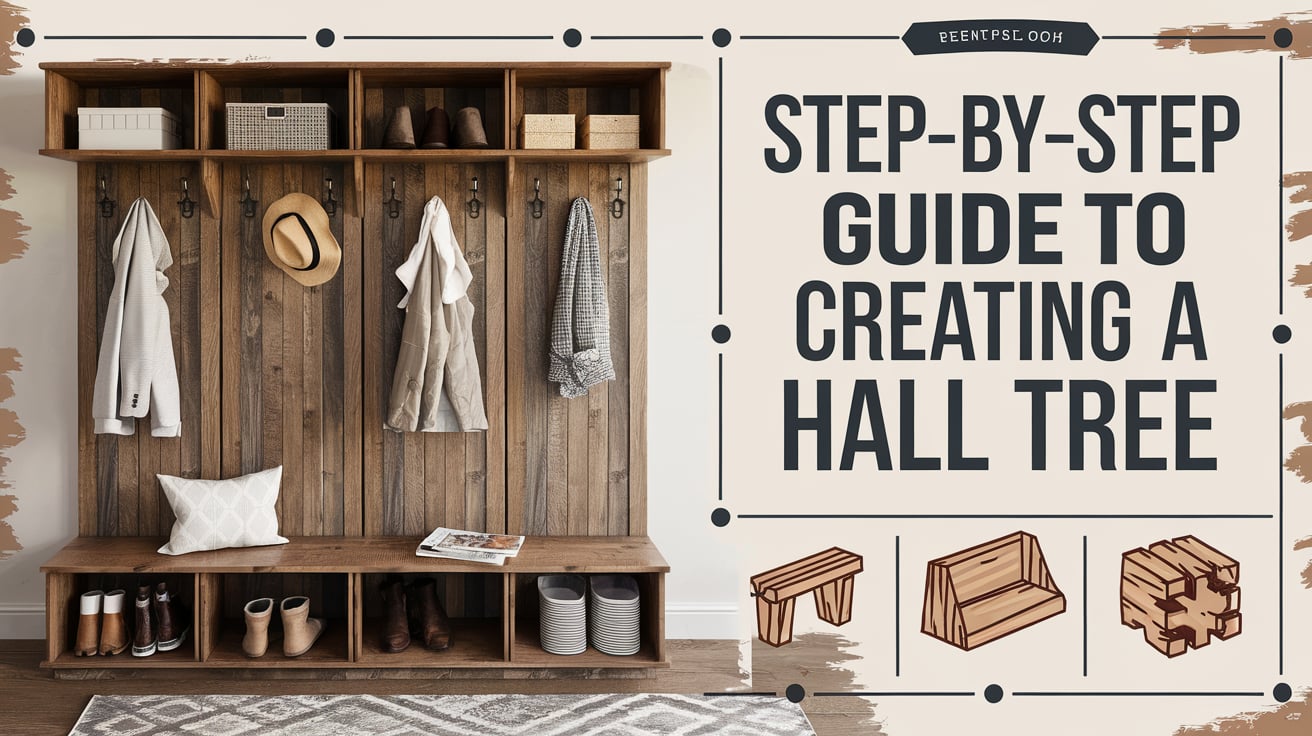Looking for a smart way to organize your entryway?
Let’s face it: With coats on chairs, shoes scattered around, and nowhere to drop your keys when you walk in, a messy entryway makes coming home feel chaotic rather than relaxing.
But you don’t need to spend hundreds on store-bought storage solutions. I’ll show you how to build a custom hall tree that perfectly fits your space and storage needs.
With some basic tools and materials, you can create a beautiful, functional piece that keeps everything tidy.
In this step-by-step guide, I’ll explain the entire process of building a hall tree, from selecting materials to adding the final finishing touches.
Tools and Materials
Tools Required
| Tool | Purpose | Quantity |
|---|---|---|
| Table saw or circular saw | To cut plywood and other pieces to size | 1 |
| Pocket hole jig (Kreg jig) | To create pocket holes for assembly | 1 |
| Brad nailer | To secure trim and face frame with brad nails | 1 |
| Orbital sander | To sand surfaces smooth before finishing | 1 |
| Drill | To drill pilot holes and screws | 1 |
| Measuring tape | To measure dimensions accurately | 1 |
| Pencil | To mark cut lines and measurements | 1 |
Materials Required
| Material | Purpose | Quantity |
|---|---|---|
| 2 sheets of plywood | For the main structure of the bench | 2 sheets |
| Extra plywood for bench seat | For making the bench seat | 1 sheet |
| 1×3 lumber (face frame) | For building the face frame | 1-2 pieces |
| 1×4 lumber (face frame, bottom, and back trim) | For face frame bottom and back trim | 2-3 pieces |
| Crown molding | For finishing the top of the bench | As needed (approx. 4-5 feet) |
| Wood glue | To bond wood pieces together | 1 bottle |
| Brad’s nails | To secure the face frame and trim | 1 pack |
| 1¼-inch pocket hole screws | To assemble parts using pocket holes | 1 box |
| Wood putty | To fill nail holes and imperfections | 1 container |
| Paint primer (Kilz 3) | To prepare the wood surface for painting | 1 can |
| Paint (Sherwin Williams) | To finish the bench with a clean, smooth coat | 1 can (quart) |
| Clear coat | To seal the painted surface for protection | 1 can (quart) |
| Iron-on edge banding | To finish plywood edges for a clean look | 1 roll |
| Wooden hooks | For hanging items on the bench | 2-4 hooks |
| Caulk (DAP Alex Flex) | To seal gaps and create cleaner joints | 1 tube |
Step-by-Step Guide
Step 1. Prepare Materials
Cut your plywood into seven equal 18-inch squares. These panels will serve as the main structure of your bench.
While cutting, make smaller strips from the leftover plywood—these will serve as support pieces. Sand every piece with 220-grit sandpaper until each surface feels smooth.
Step 2. Build Basic Frame
Add pocket holes in your panels and support strips, creating strong joints for your bench.
Make marks at 3⅜ inches on your side panels to guide bottom panel placement. Join all pieces using pocket hole screws, working section by section until your basic box structure takes shape.
Step 3. Add Face Frame
Create your face frame using 1x3s and a 1×4 for the bottom piece.
Place this frame on the front of your bench box to check the fit before attaching it. Once satisfied, attach it permanently using wood glue and brad nails, then fill any holes with wood putty.
Step 4. Install Back Panel
Connect your plywood pieces to create one large back panel. Make sure it fits properly against your bench frame.
Secure the panel using screws through pre-drilled holes to prevent splitting. Keep the unit stable as you work – it may become top-heavy.
Step 5. Add Bench Seat
Cut your bench seat to the exact size needed for your unit. Place it on top to check the fit, but don’t attach it yet.
Use this piece as a guide while you add trim pieces. Set it aside safely until final assembly.
Step 6. Install Trim
Apply 1×4 boards along the back edges of your unit. Add crown molding to the front and right side if the left side will meet a wall.
Fill any gaps between pieces with wood putty and allow proper drying time.
Step 7. First Round of Finishing
Use your orbital sander with 220-grit paper on all surfaces. Remove all dust completely before applying primer.
Apply an even coat of primer to all painted surfaces. Once dry, sand lightly again for the smoothest finish.
Step 8. Paint Application
Fill any small gaps in corners with caulk and let it dry fully. Apply your first coat of paint evenly across all surfaces. Once that dries completely, add your second coat for full coverage.
Step 9. Final Assembly
Cover any raw plywood edges with iron-on edge banding. Place your bench seat and secure it with screws through the support strips.
Add three coats of clear finish to high-use areas. Complete the look by adding your wooden hooks.
Step 10. Installation
Move your completed bench to its final spot in your home. Check that it sits level on your floor. Secure it to wall studs for safety and stability. Double-check that all pieces are firmly attached.
Video Tutorial
Check out this YouTube video for a detailed step-by-step tutorial on making a Hall Tree.
Tips and Tricks
1. Set Saw Guides Once for Multiple 18-Inch Cuts
Once your saw guides are set to the desired 18-inch width, you can cut all your pieces at once without adjusting the settings each time. This will save time and ensure consistency in your cuts.
2. Test Fit All Pieces Before Final Assembly
Before securing everything, testing and fitting all the components is important to ensure they align properly. This step can prevent mistakes and adjustments after assembly, saving time and frustration.
3. Pre-Drill Holes in Plywood to Prevent Splitting
Plywood can splinter or crack when screws are inserted directly. Pre-drilling holes ensure the screws go in smoothly and minimize the risk of splitting the wood.
4. Sand Between Primer and Paint Coats
Sanding lightly between coats of primer and paint helps smooth out imperfections and improves adhesion, resulting in a more professional, even finish.
5. Let the Caulk Dry Completely Before Painting.
The caulk needs time to dry fully before painting over it. If you paint too soon, the caulk could smudge or not adhere properly, leading to a messy finish.
6. Use Grocery Bags as Paint Tray Liners to Save Money
Instead of buying disposable tray liners, use a grocery bag. This is a cost-effective and environmentally friendly way to line your paint tray and easily dispose of it afterward.
Conclusion
Creating your hall tree takes patience and attention to detail, but the results are worth the effort.
With basic materials and careful planning, you can build a storage piece that fits your unique space and needs.
Although the process might seem complex initially, breaking it down into manageable steps makes the project achievable for anyone with any skill level.
Remember that proper preparation leads to better results—from accurate measurements to thorough sanding and adequate drying time between coats.
Take your time with each step, especially during assembly and finishing. A well-built hall tree adds function to your entryway and becomes a lasting piece that serves your family’s daily needs.
Your organized entryway awaits – start building.








